19 Days Uganda Safari tour, Rwenzori Hiking ,Congo Gorilla Trekking Tour
Explore the East & Central Africa while on 19 Days congo gorilla trekking tour & Rwenzori mountain hiking tour not missing the Virunga Mountains, Including Gorilla habituation in Kahuzi biega national Park , Climbing Mount Kahuzi, Mountain gorilla trekking in Virunga mountain, Climbing the snow capped mountain of the moon with Chimpanzee Tracking once booked with Rwenzori mountaineering service
Day 1. Transfer from Kigali to Bukavu
The guide will pick you up from your hotel in Kigali then you will drive to Bukavu. the recommended route for travelers going to congo's kahuzi biega national park ( Bukavu ) use the route via Nyungwe forest as you beautiful scenery of Rwanda’s beautiful landscape. The journey from Kigali to Ruzizi (Rwanda and D.R Congo border) takes between 7-8 hours and then around 30 minutes’ drive from the border to your hotel/lodge. Check in at hotel begonias where you will have dinner and spend the night.
Day 2. Eastern gorilla habituation/ trekking
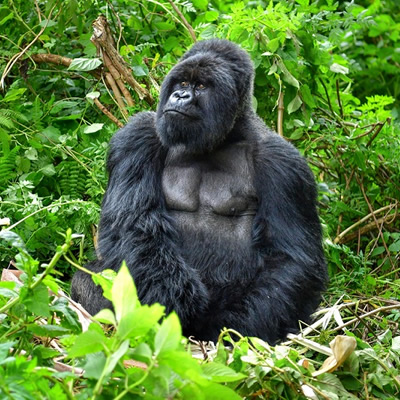
After breakfast at the hotel in Bukavu , you will transfer to gorilla trekking starting point (Kahuzi-Biega National Park). The park guide will brief you before you set out into the forest to look for the gorillas. Kahuzi-Biega National Park is a protected area near Bukavu town in the eastern area of the DRC. It is situated near the western bank of Lake Kivu and the Rwandan border. Kahuzi Biega National park is the best destination for Eastern lowland gorillas and there are a number of Gorilla families that tourists can see. The eastern lowland gorilla is a subspecies of eastern gorilla, which is endemic to the mountainous forests of eastern Democratic Republic of the Congo. The Eastern lowland gorillas that live in the Kahuzi-Biega and Maiko National park are important populations for their species.
From the starting point, you will move through the tropical forests where you will expect to see other primates like monkeys and various bird species as well as different tree and plant species. One you find the gorillas, you will be given an hour to see the gorillas as they go about their daily lives, take photos and videos. You will then return to the hotel, refresh and have lunch. Dinner and overnight at the hotel.
Day 3. Climbing Mount Kahuzi
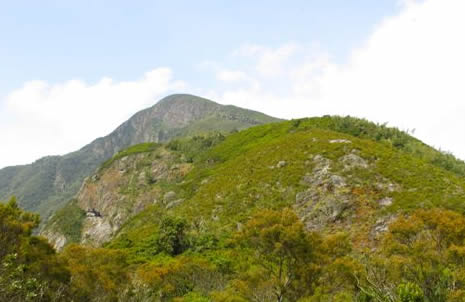
After breakfast at the hotel, you will drive to the Mount Kahuzi hiking starting point. The park guide will brief you about the whole activity. Mount Kahuzi, an extinct volcano, is the tallest peak in the area and hasn’t erupted in more than 12,000 years. Most people visit the park to see the rare lowland gorillas.
As you hike to the top of this mountain, you will go through different mini-habitats; first a lush, green jungle, where it almost seemed that the vines and bushes. Then a the bamboo forest, with straight towering poles that were cool to the touch, and very little undergrowth besides the giant asparagus-like bamboo shoots. Higher up, you will pass through low brush. Most hikers make it to the top in about 4 hours up and a bit less than that down. The hike is steep and tiresome but doable. At the top, you will be met by beautiful views of the surrounding area.
Day 4. Descend and transfer to Goma
On this day, you will check out of the hotel after your breakfast and the drive to the dock in Bukavu on Lake Kivu. Lake Kivu is approximately 90 km long and 50 km at its widest. Its irregular shape makes measuring its precise surface area difficult; it has been estimated to cover a total surface area of some 2,700 km2. The surface of the lake sits at a height of 1,460 metres above sea level. This lake has a chance of erupting every 1000 years. The lake has a maximum depth of 475 m and a mean depth of 220 m, making it the world's eighteenth deepest lake by maximum depth, and the ninth deepest by mean depth. 58 percent of the lake's waters lie within DRC borders. The lake bed sits upon a rift valley that is slowly being pulled apart, causing volcanic activity in the area.
You will take a speed boat across lake kivu to Goma. The boat ride will take you about 3 hours and as you travel across lake Kivu you will have a feel of the Lake Kivu cool breeze which is a nice one. The driver guide will be waiting for you and then transfer to Mikeno lodge where you will refresh and have lunch. Dinner and overnight at the lodge.
Day 5. Nyiragongo volcanic Hike
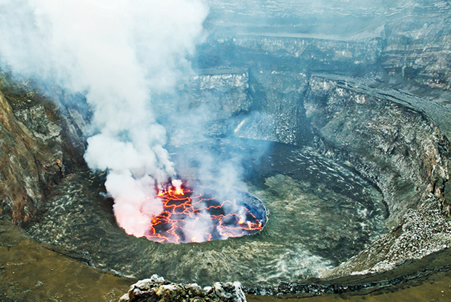
After breakfast at the lodge, you will drive to Nyiragongo hiking starting point where your guides brief you about the entire hike. You will as well be assigned guides and porters. Mount Nyiragongo is an active strato volcano with an elevation of 3,470 m in the Virunga Mountains associated with the Albertine Rift. It is located inside Virunga National Park, in the Democratic Republic of the Congo, about 20 km north of the town of Goma and Lake Kivu and just west of the border with Rwanda. The main crater is about two kilometers wide and usually contains a lava lake. The crater presently has two distinct cooled lava benches within the crater walls – one at about 3,175 m and a lower one at about 2,975 m. Nyiragongo's lava lake has at times been the most voluminous known lava lake in recent history. The depth of the lava lake varies considerably. A maximum elevation of the lava lake was recorded at about 3,250 m prior to the January 1977 eruption – a lake depth of about 600 m. A recent very low elevation of the lava lake was recorded at about 2,700 m.
As recommended by Rwenzori mountaineering service, that all hikers to going for nyiragongo climbing should go with Mikeno package by incurring an extra 100$$$, you will start the hike top the top of mount Nyiragongo through the thick tropical forests, then move through some bamboo and also some shrubs and bushes. The top parts of the mountain are majorly covered by volcanic stones formed due cooling of lava after eruptions that happened on the mountain. As you hike, you will expect to see some monkey species that live in the forests on the mountain, different tree and plant species as well as different bird species. The hike to the top majorly takes between 6-8 hours depending on the hikers speed. The top will meet you will beautiful views of the Virunga massif and the magnificent Nyiragongo lava lake. You will set your tents refresh and dinner will be served. Overnight will be in your tents on the mountain.
Day 6. Descend and cross to volcanoes national park
Travelers are always advised to wake up around 5:00 am for morning nyiragongo photos and view of the volcano for the last time and at 6:00 am you will enjoy ur breakfast , later start to descend down the hill to reach at the base, the descending is likely to take around 3-4 hours , relax abit and start the journey to goma/ Gisenyi border, cross and then proceed to volcanoes national park. Check in at Da Vinci lodge where you will have dinner and spend the night.
Day 7. Hike mount visoke and cross to Uganda
After an early breakfast at the lodge, you will drive to the Visoke mountain hike starting point. The park guides will brief you and be assigned hiking guides and porters.
Mount Bisoke which also known as Visoke is an active volcano in the Virunga Mountains, the western branch of the East African Rift. It straddles the border of Rwanda and the Democratic Republic of the Congo, but the summit is located in Rwanda. It is located approximately 35 km northeast of the town of Goma and adjacent Lake Kivu. With all your hiking package, you will start the hike to the top. It takes about 4-5 hours to reach the top. As you hike you will expect to spot some monkey species as well as different bird species. You will return to the lodge refresh and have lunch. You will then check out of the lodge and then transfer to Kisoro through the Cyanika border. Check in at countryside guest house, have dinner and spend the night.
Day 8. Mountain gorilla trekking in Uganda
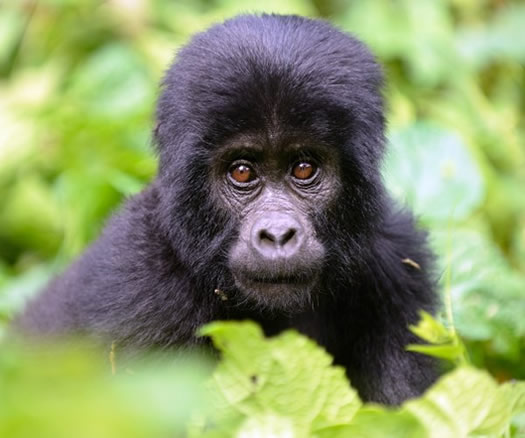
After breakfast at the lodge, you will transfer to mount Mgahinga national park headquarters. You will be briefed by the park guide about the activity and have your permits verified. Mgahinga Gorilla National Park sits high in the clouds, at an altitude of between 2,227m and 4,127m. As its name suggests, it was created to protect the rare mountain gorillas that inhabit its dense forests, and it is also an important habitat for the endangered golden monkey. As well as being important for wildlife, the park also has a huge cultural significance, in particular for the indigenous Batwa pygmies. The park is a home to only one gorilla group which is led by an elder siverback, ‘nyakagezi’.
You will then move through the forests to look for the mountain gorillas. The activity will take around 3-5 hours depending on where the gorillas will be that day. When you find them, you will be given an hour to watch the gorillas as they go about their daily life, and also take photos. Return to the guest house and have lunch. Dinner and overnight at the guest house.
Day 9. Transfer to kasese
After breakfast at the lodge, you will check out and then transfer to Kasese. This journey will take around 5-6 hours with a stopover along the way for lunch. You can either pass via Kisoro- Ishaka- Kasese route or you can choose to pass through the Ishasha sector of queen Elizabeth national park and do a fast game drive to look for the tree climbing lions. Check in at sandton hotel where you will have dinner and spend the night.
Day 10. Transfer to the base in and start the hike. Kilembe (1,450m) to Kalalama (3156m)
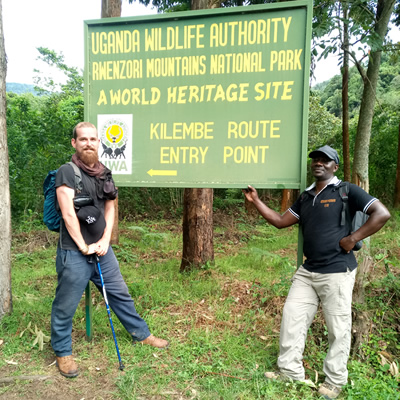
As its well noted , the Rwenzori Climber will be using the kilembe Trail Route ( Rwenzori Trekking Services) You will head straight to the camp base from your hotel in either Kasese or Trekkers Hostel (1.450 m), which is actually considered the camp base. Today you will walk through the mountain forest zone, where you might have encounters with species of monkeys like the colobus monkeys and the blue monkeys, then birds like the Rwenzori Turaco. Before reaching Sine Hut, the arrival point of the day at 2.585 meters altitude, you stop over at Enock’s fall, a beautiful scenery. The Sine Hut is located between forest trees. You will be served the dinner and spend the night. The first day involves a long steady climb through montane forest and bamboo to a campsite at Kalalama in the heather zone.
Day 11: Kalalama Camp (3.147m) to Mutinda Camp (3.688 m)

After breakfast, trekking starts at 8.30 Am and you soon enter the bamboo-mimulopsis zone, which is steep climb with many high steps. After about 1.8 kilometers you reach Kalalama Camp (3.147 meters), which is located in the heather –rapanea zone. Here you will have a rest and a cup of tea. From this point you proceed along the heather zone, passing by several streams and even waterfalls, all covered by the typical green moss vegetation.
You will see a lot of Giant Heather trees, sometimes in a misty atmosphere. The arrival point of the day is Mutinda Camp, at 3.688 m named after the Mutinda Peaks. From this point, you can climb further to Mutinda Lookout, 3.925 m, about one hour and half walk plus one hour to descend back to the camp. The place is worth a visit as you stand on moss covered rocks with views across the Rwenzori Mountains, down to Kasese town and Lake George
Day 12. Mutinda to bugata camp
The trail to Bugata Camp is boggy particularly in the wet season but with a little skill you can step from tussock to tussock to make the going easier. First you cross the Mutinda valley through the tussock grass and everlasting flowers interspersed with many Giant Lobelias before climbing a steep section up to the Namusangi Valley (3,840 meters), with sheer waterfalls and looking back you get fantastic views of Mutinda Peaks. The Namusangi Valley is wide, with many ups and downs as the trail climbs steadily to Bugata Camp at 4,100 metres.
Day 13. Bugata to hunwicks (3874m)
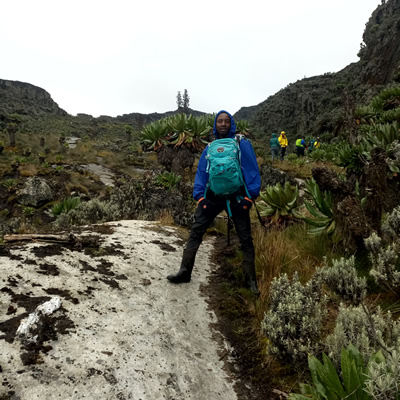
Trek to Hunwick’s Camp via Bamwanjarra Pass. As you leave Bugata Camp you pass up a ridge then drop down slightly before ascending to Bamwanjarra Pass at 4,450 meters where we have a hut should the weather turn bad. From the pass on a clear day you get excellent views of the three main peaks. The trail passes down the valley and around the edge of some bogs and thick ever green vegetation, moss, Giant groundsel and lobelia. Here is possibly the best place in all the Rwenzori to observe the Malachite Sunbird as it feeds on the many lobelia flowers and a known breeding site. Farther on there is some steep sections before a steady climb up and over a ridge to Hunwick's Camp which is situated on the top of a deep valley and has good views of Mt Stanley, Mt Baker, Weismanns Peak and McConnell’s Prong.
Day 14. Hunwick to Margherita camp (4485m)
From Hunwick's you pass down and across the valley floor to Lake Kitandara which is very stunning with deep water and beautiful vegetation. From here you climb up Scott Elliott's pass then up the ridge to Margherita Camp 4,485 metres which is situated between some huge rocks and offering some shelter from the strong winds. This is the very spot where the Duke of Abruzzi camped when making his climb to Margherita Peak in 1906. Dinner and overnight at margherita camp.
Day 15. Margherita to Hunwick
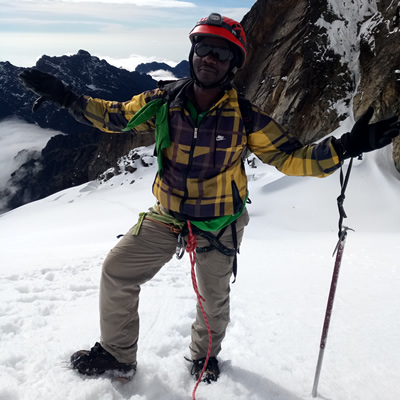
Wake up at 2am and catch an early breakfast before heading off to climb Mt Stanley at 2.30am. hike to the top of mount Stanley, Magharita peak, through the stanely plateau and magherita Glaciers, then descend to Margherita camp for Lunch and later proceed to descend to Kitandara through the scott Elliot pass back to Hunwick, it is the most beautiful point of the Rwenzori. Dinner and overnight at Hunwick.
Day 16. Hunwick to Kiharo
Distance to Kiharo Camp 11km Time taken to walk 4 to 7 hours, from Hunwick’s Camp you start the day by climbing up a ridge towards McConnell’s Prong where you get the best views of all three peaks and Scott Elliott’s Pass before reaching Oliver’s Pass at 4,505 metres. On a clear day you get fantastic views of Margherita and Mt Stanley, Mt Speke and Mt Baker. Dinner and overnight at Kiharo camp.
Day 17. Kiharo back to the base & Transfer to Kibale Forest national park
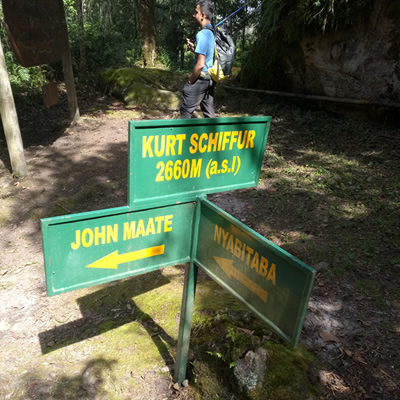
Distance Kiharo Camp to the park gate 12.2km and another 2.8km down to Trekkers Hostel Time to walk 5 to 8 hours. The trail down the Nyamwamba Valley is mostly downhill and absolutely stunning with beautiful views, moss covered rocks along the river, cascading waterfalls, deep valleys and forests are possibly the best in the Rwenzori Mountains. At the bottom you meet the river where there is a huge rock shelter and a place to rest for a while.
After crossing a small stream you climb up a gentle slope before turning back down to the river to avoid another set of waterfalls which are impassable. The forest along this section is magnificent and full of life with many birds, primates, dikers and hyrax. A great experience and ending to a fantastic trek. The guide will be at the base waiting for you and then transfer to Kibale forest national park. This journey will take you about 2 hours. Check in at Isunga lodge where you will have dinner and spend the night.
Day 18. Chimpanzee tracking in Kibale Forest national park
After breakfast at the lodge you will drive to Kibale forest national park headquarters where you will be briefed about chimpanzee trekking and the park in general. Kibale forest national park is highest at the park’s northern tip, which stands 1,590m above sea level and the lowest point is 1,100m on the floor of the Albertine Rift Valley to the south. It covers an area of about 795 square kilometers. Kibale’s different altitude supports different types of habitat, ranging from wet tropical forest on the Fort Portal plateau to woodland and savanna on the rift valley floor. Most tourists visit the park to trek chimpanzees. Apart from the chimps, the forest is a home to other primates like monkeys, mangabey, baboons, wild pigs, various fish species among others. Chimpanzee trekking can be done in the morning; which starts at 8am, mid-morning; starts at 11am and in the afternoon; starts at 2pm.
After your briefing you will then move through the forest to look for the chimps. Unlike gorillas, chimpanzees keep moving around the forest and jump from one tree to another as they go about their daily life. So do not expect to find them in one place. As you trek the chimps, you will expect to see other primates that live in the forest as well as various birds species like the great blue turaco. You will then return to the lodge refresh and have lunch. Dinner and overnight at the lodge.
Day 19. Transfer to Kampala
After breakfast at the lodge, you will check out and then transfer back to Kampala. You will pass via the Fortportal-Mubende-Kampala highway which will take around 5hours. You will have a stopover at a restaurant in Kampala for lunch. The guide will drop you at your hotel in Kampala/ Entebbe or at Entebbe airport for your flight back home.


